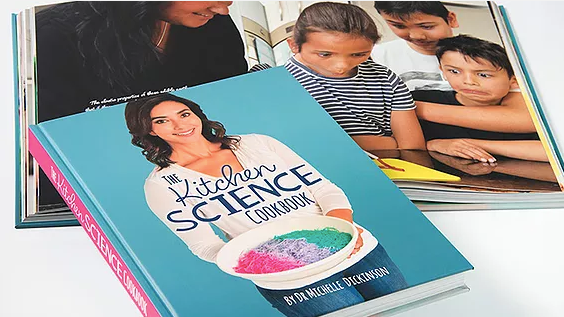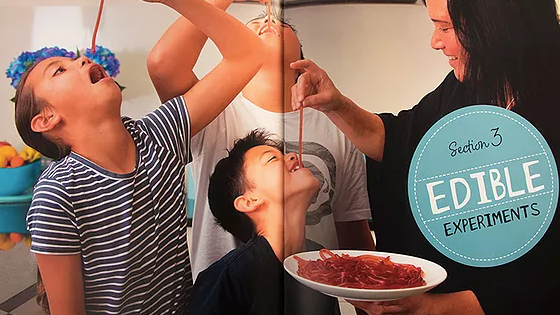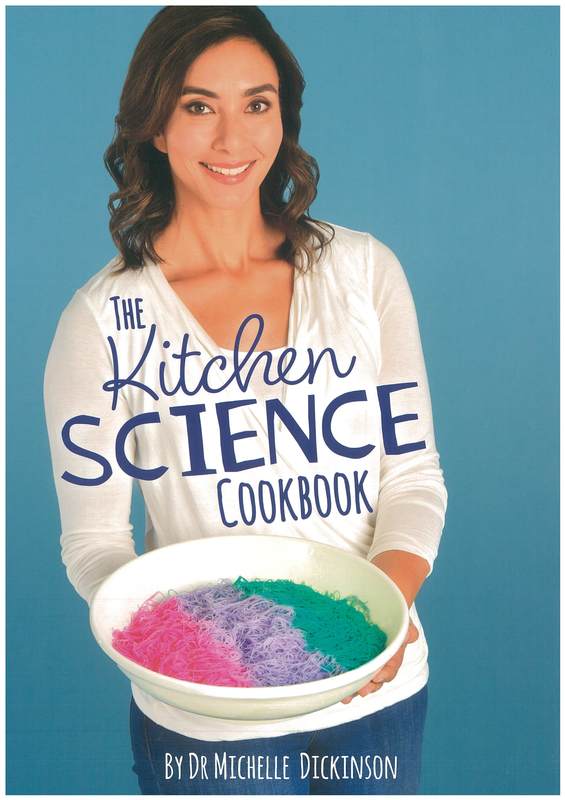If you like getting creative in the kitchen with children, Dr Michelle Dickinson – Nanogirl – has a new book out to stretch you further. Dr Siouxsie Wiles tells us why you should take a look.

One thing I loved about becoming a parent was the excuse to do science experiments with my daughter. For her sixth birthday party I put on a Harry Potter-themed ‘Potions’ class where the kids and I experimented with a whole bunch of simple chemical reactions. I was surprised to find out that the other children had never done any of the experiments before. Apart from the dry ice, everything we used was a common ingredient that could be found in almost every home in the country. Why were we the only family playing around with bicarbonate of soda, food colouring, and cornflour?! Is it because I make my living as a scientist and have no fear of turning my kitchen or bathroom into a laboratory and experimenting?
Dr Michelle Dickinson is an engineer and science communicator who has made it her mission to show that science is for everyone. She tells the story of being given a home-made cake by a lady who wished that she was good at science. Yet here she was, handing Michelle the result of a successful chemistry experiment: her light and fluffy cake was made that way by the carbon dioxide produced when baking soda and cream of tartar get wet. As Michelle says, ‘she was a scientist.’
That chance meeting sowed the seed for The Kitchen Science Cookbook, which uses the format of a cookbook to introduce the worlds of chemistry, physics, biology, and engineering through 50 simple and cheap experiments.

The experiments in the book are divided into nine sections, including colourful experiments, construction experiments, and edible experiments. Each experiment is clearly laid out, just like a recipe, starting with a list of the equipment and ingredients needed, followed by the instructions and an indication of how long the experiment should take to do.
Because this is a science cookbook, there is also a section that explains the science behind each experiment, written in simple language that everyone can understand. There are also heaps of suggestions for how to tweak each experiment to explore the subject further.
There is so much to love about this book.
There is so much to love about this book. It’s beautifully laid out and illustrated, and its pages are filled with photos of children and their whanau doing the experimenting. Every child will be able to see themselves in this book. And there is a great range of experiments, from the messy and delicious-looking ‘Scrumptious slime’ to the amazing ‘Egg in a bottle’. But it’s the thoughtful little touches that make The Kitchen Science Cookbook stand out. Its contents page is made up of icons from each of the experiments so that experimenters not quite reading on their own can easily find the page they want. The book is also printed on heavy glossy paper which means the pages won’t tear if they are turned too quickly in all the excitement and can easily be wiped clean after all that messy experimenting.
Michelle started with ideas for 350 experiments. She whittled that down to the 50 in The Kitchen Science Cookbook with the help of some 2,000 people from 24 countries who volunteered to trouble-shoot the recipes. That means Michelle still has another 300 experiments up her sleeve. I can’t wait for The Kitchen Science Cookbook Volume 2.

Siouxsie Wiles
Associate Professor Siouxsie Wiles is an award-winning scientist who has made a career of manipulating microbes. She and her team at the University of Auckland make bacteria glow in the dark to understand how infectious microbes make us sick and to find new medicines. Siouxsie was named a Blake Leader by the Sir Peter Blake Trust in 2016 and was one of three finalists for the 2018 Kiwibank New Zealander of Year award. In 2017 she published her first book, ‘Antibiotic resistance: the end of modern medicine?’ as part of the Bridget Williams Books BWB Texts series.



